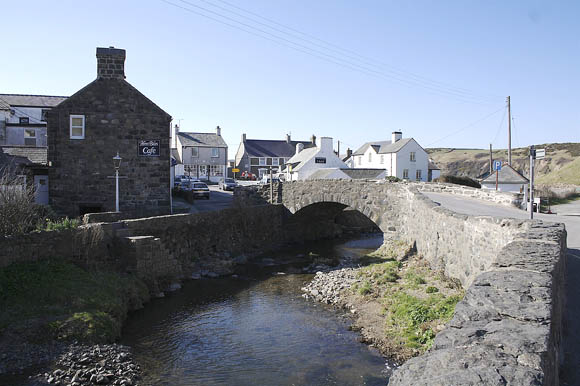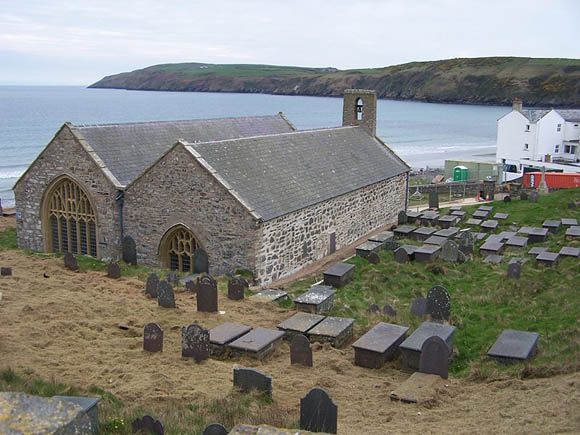Aberdaron (Aber-Daron) - From 'A Topographical Dictionary of Wales' (1849)
ABERDARON (ABER-DARON), a parish, in the union of Pwllheli, hundred of Commitmaen, Lleyn division of the county of Carnarvon, North Wales, 13 miles (W. S. W.) from Pwllheli; containing 1350 inhabitants. This parish, which is situated on the extreme point of the peninsula of Lleyn, the Promontorium Langanum of Ptolemy, derives its name from the small river Daron, which here falls into the sea, off Bardsey Race. In 1115, Grufydd ab Rhŷs, Prince of South Wales, took sanctuary in the church of Aberdaron, from the treachery of Grufydd ab Cynan, sovereign of North Wales, who intended to deliver him into the hands of the English monarch, Henry I. Grufydd ab Cynan commanded the fugitive prince to be dragged from his asylum by force; but his soldiers were unable to execute his orders, from the strenuous resistance opposed to them by the clergy of the neighbourhood, who successfully exerted themselves in defence of the privileges of the Church. The young prince escaped with his partisans by night, and set forward on his journey to the deep forest of Strath Towy, in South Wales, where, having collected the adherents of his family, he commenced hostilities against the Norman and Flemish settlers. Aberdaron was anciently much resorted to by devotees, as a place of embarkation for Bardsey Island, on their pilgrimage to the celebrated monastery established there; and on the summit of the promontory are some slight remains of the ancient Capel Vair, or Chapel of Our Lady, erected for the use of the mariners, who, previously to entering upon the dangerous navigation of the sound, were accustomed to invoke the protection of its tutelar saint. At a small distance from it, and near the shore, are the remains of another chapel, called Capel Anhaelog, which, like the former, was suffered, after the dissolution of Bardsey monastery, to fall into decay.
The parish, which is intersected by the road leading from Pwllheli to the extremity of Lleyn, is bounded on the north by the parish of Llangwnadal, on the north-east by that of Brncroes, on the east by the parishes of Llanvaelrhŷs and Rhiw, and on the south and west by the sea. It comprises by admeasurement 6794 acres, of which about one fourth is arable, and the remainder pasture; the soil is generally of good quality, resting upon clay, and the chief produce is wheat, barley, oats, and potatoes. The surface is tolerably level, varied by a few hills and mountains, and enlivened by the windings of the rivers Daron, Leos, and Afon Saint: the coast scenery is on the grandest scale. Among the gentlemen's seats are Badwrdda, Carreg, and Methlem. A stratum of excellent limestone has been discovered, which, from the scarcity of limestone in this part of the country, promises to be of great benefit to the farmers as a valuable source of manure. Lead-ore has also been found in small quantities, and several attempts have been made to find copper, but these have not proved successful: manganese and slates have been raised, but the works are at present at a stand. There are three mills, in each of which five men are employed, and a factory and a fulling-mill, each giving occupation to three hands. The village is small, chiefly inhabited by fishermen, and, by its isolated situation and the want of good roads, precluded from much intercourse. On market days during the summer, there is facility of communication with Pwllheli, from which place the inhabitants are supplied with necessaries; they also trade by sea with Liverpool, to which port vessels sail regularly every week with pigs, poultry, and eggs, and from which they return laden with coal for the supply of the neighbourhood. A fair is held annually on the 26th of June.
The living is a discharged vicarage, with the perpetual curacy of Llanvaelrhŷs annexed, rated in the king's books at �3. 9. 4�., endowed with �200 private benefaction, and �200 royal bounty; patron, the Bishop of Bangor. The total net income of the joint living is �120. There is also a sinecure rectory, rated at �10. 9. 4�., and in the patronage of the Master and Fellows of St. John's College, Cambridge, who usually present a fellow of that college. The lay impropriator's tithes in Aberdaron have been commuted for a rent-charge of �242, the rectorial tithes for �194, the vicarial for �73, and the tithes of the parish-clerk for �10. The old church, dedicated to St. Hyrwyn, a saint of the island of Bardsey, was formerly collegiate, and had the privilege of sanctuary. It consists of two aisles of equal dimensions, each being sixty-nine feet long inside; and, though now disused as a place of worship, appears to have been an elegant and highly finished building. The northern aisle is the older portion, though itself not entirely of the same date; it is entered by a circular-headed doorway in the western wall, of the Romanesque style, above which is a bell-turret with a square head. Probably, this aisle formed part of the original church, and on an enlargement of the whole edifice being made, by the addition of a southern aisle, the altar was transferred to the latter, which became the more important part of the building. The southern aisle is separated from the northern one by five arches, on octagonal piers of good elevation; it has a large and handsome east window of the later English style, and a screen of plain work separating the chancel portion from the nave. In lieu of this edifice, a new church was lately erected, situated about half a mile in a northern direction, from the old one. It was consecrated on the 28th of September, 1841, and is a plain building, sixty-six feet long, and thirty-four broad, with two turrets at the western end; the edifice contains 600 sittings, of which 340 are free, and was erected at a cost of �1300. There are several places of worship for dissenters.
A day school has been established here, for this parish and the parish of LlanvaelrhŶs; it is partly supported by the parents of the children, and partly by an endowment of �4. 11. a year, being half the rent of a dwelling, out-buildings, and nearly 7 acres of land, in the parish of Llaniestyn, purchased with a bequest of �80 left by Robert Evans in 1784, together with subscriptions subsequently raised. Formerly a school was held, agreeably with the endowment, in the four parishes of Aberdaron, Llanvaelrhŷs, Rhiw, and Br&ncroes, for a year in each, in rotation; but an arrangement has been made by which one school has become permanent at Aberdaron, and another at Br&;ncroes, the endowment being shared between the two masters. There are also five Sunday schools in the parish, one of them in connexion with the Church, two with the Calvinistic Methodists, one with the Wesleyans, and one with the Baptists. A poor man of the parish is entitled to support in the almshouse at Bangor, under the will of the founder, Bishop Rowlands. In 1704 Catherine Bodwarda devised a house, out-buildings, and about twelve acres of land, now let at �9 per annum, for apprenticing poor children, and from this charity one or two are annually so put out, with premiums varying from �4 to 12. About �3. 6., arising from the gifts of unknown donors, are distributed in small sums among the poor at Easter; and twelve bottles of port wine are received annually by the churchwardens for the use of the sacrament, from Mr. Wynne, this also being the gift of an unknown benefactor. Magdalen Parry, in 1781, bequeathed �30 to the poor, but this sum is for the present unproductive. An inclosure of waste lands was made in the parish, under an act of parliament, in 1807.
The courts for the manor of Bardsey were formerly held at a house in this parish, which still bears the name of "Court," and on an eminence near it, called Brynn y Crogbren, or the "Gallows' Hill," criminals were probably executed; another house in the neighbourhood is styled Secar, signifying the "Exchequer." On the side of a hill called Mynydd Moelvie, or Mynydd yr Ystum, are the ruins of an ancient chapel, named Capel Odo; and in the vicinity is a tumulus, called Bedd Odo, or "Odo's grave," which, according to tradition, covers the remains of a giant of that name. Below the cliff occupied by the ruins of Capel Vair is the cave of Ogo Vair, in which is a well, formerly much frequented by devotees, who superstitiously believed that, by carrying a mouthful of the water up a circuitous and dangerous path to the summit of the hill, whatever wish they might entertain would be accomplished. At Aberdaron was born, in 1778, Richard Robert Jones, whose poverty and extraordinary skill in the acquisition of languages attracted the sympathies of the late Mr. Roscoe, by whom a subscription was opened for his benefit. He is said to have learned thirteen different languages, without the aid of a master. His death took place at St. Asaph in 1845. |




